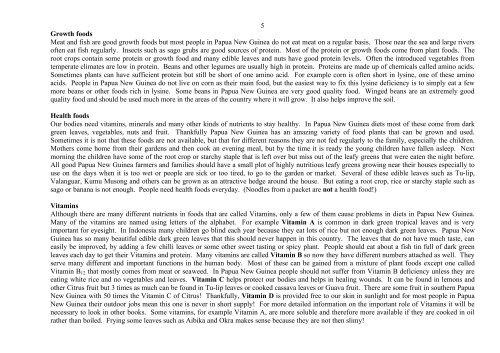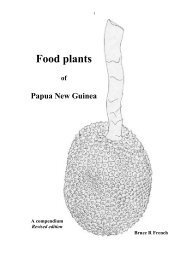Food Composition PNG plants - Food Plants International
Food Composition PNG plants - Food Plants International
Food Composition PNG plants - Food Plants International
Create successful ePaper yourself
Turn your PDF publications into a flip-book with our unique Google optimized e-Paper software.
5<br />
Growth foods<br />
Meat and fish are good growth foods but most people in Papua New Guinea do not eat meat on a regular basis. Those near the sea and large rivers<br />
often eat fish regularly. Insects such as sago grubs are good sources of protein. Most of the protein or growth foods come from plant foods. The<br />
root crops contain some protein or growth food and many edible leaves and nuts have good protein levels. Often the introduced vegetables from<br />
temperate climates are low in protein. Beans and other legumes are usually high in protein. Proteins are made up of chemicals called amino acids.<br />
Sometimes <strong>plants</strong> can have sufficient protein but still be short of one amino acid. For example corn is often short in lysine, one of these amino<br />
acids. People in Papua New Guinea do not live on corn as their main food, but the easiest way to fix this lysine deficiency is to simply eat a few<br />
more beans or other foods rich in lysine. Some beans in Papua New Guinea are very good quality food. Winged beans are an extremely good<br />
quality food and should be used much more in the areas of the country where it will grow. It also helps improve the soil.<br />
Health foods<br />
Our bodies need vitamins, minerals and many other kinds of nutrients to stay healthy. In Papua New Guinea diets most of these come from dark<br />
green leaves, vegetables, nuts and fruit. Thankfully Papua New Guinea has an amazing variety of food <strong>plants</strong> that can be grown and used.<br />
Sometimes it is not that these foods are not available, but that for different reasons they are not fed regularly to the family, especially the children.<br />
Mothers come home from their gardens and then cook an evening meal, but by the time it is ready the young children have fallen asleep. Next<br />
morning the children have some of the root crop or starchy staple that is left over but miss out of the leafy greens that were eaten the night before.<br />
All good Papua New Guinea farmers and families should have a small plot of highly nutritious leafy greens growing near their houses especially to<br />
use on the days when it is too wet or people are sick or too tired, to go to the garden or market. Several of these edible leaves such as Tu-lip,<br />
Valanguar, Kumu Musong and others can be grown as an attractive hedge around the house. But eating a root crop, rice or starchy staple such as<br />
sago or banana is not enough. People need health foods everyday. (Noodles from a packet are not a health food!)<br />
Vitamins<br />
Although there are many different nutrients in foods that are called Vitamins, only a few of them cause problems in diets in Papua New Guinea.<br />
Many of the vitamins are named using letters of the alphabet. For example Vitamin A is common in dark green tropical leaves and is very<br />
important for eyesight. In Indonesia many children go blind each year because they eat lots of rice but not enough dark green leaves. Papua New<br />
Guinea has so many beautiful edible dark green leaves that this should never happen in this country. The leaves that do not have much taste, can<br />
easily be improved, by adding a few chilli leaves or some other sweet tasting or spicy plant. People should eat about a fish tin full of dark green<br />
leaves each day to get their Vitamins and protein. Many vitamins are called Vitamin B so now they have different numbers attached as well. They<br />
serve many different and important functions in the human body. Most of these can be gained from a mixture of plant foods except one called<br />
Vitamin B12 that mostly comes from meat or seaweed. In Papua New Guinea people should not suffer from Vitamin B deficiency unless they are<br />
eating white rice and no vegetables and leaves. Vitamin C helps protect our bodies and helps in healing wounds. It can be found in lemons and<br />
other Citrus fruit but 3 times as much can be found in Tu-lip leaves or cooked cassava leaves or Guava fruit. There are some fruit in southern Papua<br />
New Guinea with 50 times the Vitamin C of Citrus! Thankfully, Vitamin D is provided free to our skin in sunlight and for most people in Papua<br />
New Guinea their outdoor jobs mean this one is never in short supply! For more detailed information on the important role of Vitamins it will be<br />
necessary to look in other books. Some vitamins, for example Vitamin A, are more soluble and therefore more available if they are cooked in oil<br />
rather than boiled. Frying some leaves such as Aibika and Okra makes sense because they are not then slimy!



